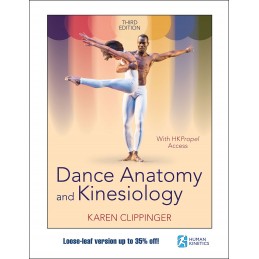This is the loose-leaf version of
Dance Anatomy and Kinesiology, Third Edition, which offers students a less expensive printed version of the text.
Karen Clippingers first two editions of
Dance Anatomy and Kinesiology were hailed as the standard in the field. This third edition builds on that success by retaining its scientific perspective while making the material even more accessible to students and teachers and by bringing in a significant amount of new material.
Whats New? In an effort to further enhance learning,
Dance Anatomy and Kinesiology offers a wealth of new material and tools to make this edition the best yet::
- Nearly 300 anatomical illustrations—now in full color to clearly show muscle movements and technique considerations, setting the book apart from others in its field
- A new introductory chapter to cover basic terminology all in one place
- A new recurring Understanding Check element that helps students demonstrate their grasp of the material before moving on
- An updated suite of online instructor and student ancillaries to support the text
- New interactive lab activities delivered online through HKPropel
- More diverse dance styles addressed throughout the book and represented in photographs
The instructor guide features a sample syllabus and course outline, chapter outlines, lab assignments, and sample tests. A presentation package provides expanded chapter slides with more in-depth texts and additional graphics, now in color, that reinforce each chapters key points.
Through HK
Propel, students have access to interactive Understanding Check activities, flash cards, practice quizzes, and 19 video clips that demonstrate technique and offer correction guidance.
The final chapter is revised to provide a summary and applications, including more practical content in the form of summary figures or tables for bones, joints, muscle actions, and alignment evaluation, as well as sample mat exercises for dance conditioning. And throughout the book, Clippinger has updated content to simplify, add more practical material, and share best practices for injury prevention and rehabilitation.
Primary Focus While much is new in this third edition, the book retains its emphasis on presenting the anatomical and kinesiological material that is essential for dancers to understand. The text includes descriptions of joint structure, key muscles, movement analysis, sample strength and flexibility exercises, common alignment problems, select joint mechanics, and special considerations for dance for each region of the body.
The new edition still features the Concept Demonstration and Dance Cues special elements. The former provides movement experiences for dancers to better understand potentially difficult concepts, while the latter helps the dancer reflect on the anatomical basis of commonly used cues used in teaching dance technique.
Empowers Instructors and Dancers This new edition of
Dance Anatomy and Kinesiology will give teachers a clearer picture of the anatomical and kinesiological factors that aid in generating technique cues and identifying technique problems, and it will help them become more effective and empower dancers to realize their potential and artistic vision.
Note:: A code for accessing HK
Propel is included with all new print books.




 Delivery policy
Delivery policy
 Security policy
Security policy
 Return policy
Return policy
